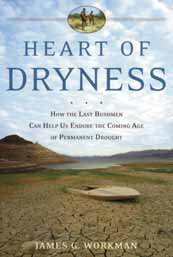SEJournal Online is the digital news magazine of the Society of Environmental Journalists. Learn more about SEJournal Online, including submission, subscription and advertising information.

BookShelf
Heart of Dryness: How the Last Bushmen Can Help Us Endure the Coming Age of Permanent Drought
By James G. Workman
Walker & Company, $26
Reviewed by GREG HARMAN
In the history of the conservation movement, notions of wilderness have rarely included people. Homo sapiens were universally tagged as the hapless despoilers of the land. Nearly 30 years ago, writer Gary Paul Nabhan exposed a notable exception to this ingrained prejudice by examining two desert oases — A'al Waipia, located inside Arizona's Organ Pipe Cactus National Monument, and Ki:towak, across the Mexican border.
De-peopled of subsistence farmers by the U.S. Parks Service in 1957, A'al Waipia had since choked on sediment, Nabhan wrote in The Desert Smells Like Rain. It regressed to a quiet pond visited by few animals or people, while across the border, at Ki:towak, fruit trees bloomed and insects rushed about thanks to irrigation that made use of local springs. Native greens and healing herbs grew across the border and biological surveys showed human partnership with the land doubled the amount of bird species present.
The Parks system also drove out Lakota, Crow, Blackfeet, and Miwok from enormous parks like Yellowstone and Yosemite to preserve that "virgin" country. And so it was that the government of former president Festus Mogae began to drive the Bushmen of Botswana's Kalahari Reserve off their land while exploiting global affection for the African elephant, writes James Workman in Heart of Dryness.
In his well-researched book, Workman argues that our increasingly thirsty world desperately needs the knowledge of those we persecute in the name of saving the Earth.
Workman tracks the unraveling of what had been one of the most successful democracies in Africa as Mogae pressed for the total removal of the few remaining bands of subsistence hunter-gatherers who attempted — during what turned out to be the planet's hottest years on record — to hold onto their traditional ways. The fight came to a climactic moment a few years ago when he ordered the dismantling of the sole federal water pump inside the game reserve. Workman spent time with the Bushmen, learning how they gathered the water they needed from a parched landscape.
Though many human-rights organizations mobilized against Mogae's efforts to drive out the Bushmen, Workman suggests it got a wink from American and European wildlife biologists. After all, in protecting the elephant's wide-ranging habitat, entire ecosystems are preserved as well. For Botswana, there was nothing quite like it for the balance sheet: tourism-related revenues climbed in pace with the growth of the elephant population. "The trouble with indigenous people, it seemed," Workman writes, "was that they generated insufficient cash flow, especially foreign exchange from ecotourists."
But it wasn't only elephants and tourist dollars motivating Mogae's government to sustain a low-intensity war upon the Bushmen. The world's largest diamond company, De Beers, reportedly had its eye on the Kalahari for new mining sites. In a region where native peoples are frequently relocated to make way for development projects, the case against the Bushmen was exacerbated by the inherited racism of the dominant Tswana, many of whom ridiculed the Bushmen as a "serf" class or as embarrassing "Stone Age" creatures. "If the Bushmen want to survive, they must change," Mogae had said in 1996, "otherwise, like the dodo they will perish."
Workman uses the story of Bushmen resistance to tell a broader story about the looming global water crisis that is already recasting political relationships around the planet. Ultimately, Workman's book is a rallying cry. It is a call to trade in our leaky, centralized water systems and water-hogging agricultural methods with a decentralized model based upon indigenous principles. For example, fundamental rights to water would be honored for all, but only at a level to ensure healthy survival.
He turns the tables on centuries of hydrological thought to ask, "What Would the Bushmen Do?" The answer — to Workman's mind — doesn't flow from a United Nations resolution establishing an inherent human right to water. Neither does it come through privatization. Instead it sits somewhere like a submerged Kalahari sip well, beckoning us to part the sands, fashion our reeds, and reevaluate the value of life itself.
Greg Harman is a staff writer at the San Antonio Current. He also runs the blog Harman on Earth.
** From the quarterly newsletter SEJournal, Spring 2010 issue.












 Advertisement
Advertisement 



